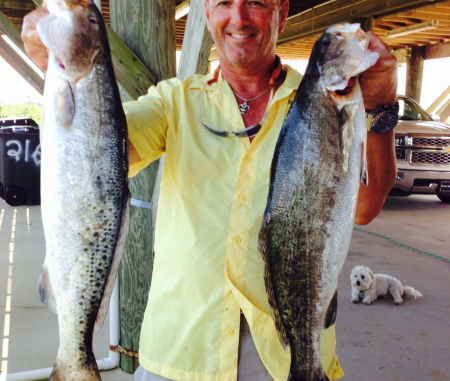
Learn to free-line around structure to put your live bait in the strike zone
Even by his lofty standards, Tommy Vidrine enjoyed an extra-special weekend of trout fishing around Grand Isle.
The Baton Rouge angler who specializes in catching big specks caught his personal-best stringer, coming in with five fish weighing almost 27 pounds at the ABC Rodeo held at the Sand Dollar Marina.
Vidrine, who caught most of his stringer fish with live shrimp and pogeys along the Fourchon rocks and beach, recently shared several of his personal tips and tactics to catch big specks with LouisianaSportsman.com.
In recent articles, he has discussed trolling motor and anchoring techniques, as well as setting the hook on big trout and how he rigs up live bait.
Today, he shares his thoughts on free-lining and casting placement when he’s fishing along rocks, and noted that a difference of just a few feet either way could be the difference between catching a 4- or 5-pounder and not even getting a nibble.
“The big mistake I see most people make is they’re too far from the structure,” Vidrine said. “If you’re rock fishing, the bait needs to almost hit the rocks and fall straight down. Those trout are smart and they’re sitting down there and they’re not going to chase a bait.
“When that shrimp or pogey or croaker gets hit against that rock, it’s kind of disoriented and falls down right at the bottom of the rocks. Guess who’s waiting for the disoriented bait? Mr. Big Trout is waiting to get easy prey.”
That’s why Vidrine believes free-lining is crucial skill to learn, using only 15-pound mono line and either a 2/0 circle hook (for shrimp) or a 4/0 Kahle hook (for pogeys and croaker).
No split shot. No Carolina rig.
Just the line, the hook and the live bait.
“If you’re throwing your bait into those rock and just letting it fall down, you can’t really put a weight on it doing that. You have to free line,” he said. “You have to let if fall down right on the edge. That’s where I’m catching all my nice trout.
“I just hook that croaker through the back, throw him into those rocks and let him find me a big trout.”
Because Vidrine believes large trout are almost lazy when eating, and much prefer bait to come to them, being able to position the bait and keep it in the strike zone is key.
“You’ve got to be as close to the rocks as you can without getting hung up. If you’re free-lining, you’ve got to get yourself where you’re 25 feet from the structure,” he said. “That’s where the trout are and if you’re not doing that, you could pull it two feet off the rocks and not get a bite.
“Most people are too far and they don’t catch a fish and they give up on it.”
And when he uses live croakers, Vidrine says it’s easy to tell when the bait is about to get hammered by a big trout.
“You’ll feel a difference in the swimming of the croaker. Believe me, he sees that trout or redfish coming and he starts swimming hard for his life,” he said. “So when you start feeling that shake on the tip of the pole, the next thing you know about three seconds later, you feel that big thump.”
When the live bait moves away from the rocks, Vidrine reels in and throws back to his spot.
“You’ve got to stay in the strike zone,” he said. “If you come out the strike zone, reel it in and cast it back out.”
If you do use a Carolina rig, Vidrine said to allow for at least three feet of line from your weight to the hook.
“That croaker needs to be able to swim with the hook. You don’t want it to pull the fish down where he can’t have action,” Vidrine said. “Make sure he’s got at least three feet to move around so it looks more natural.”
In the next article in the series, Vidrine discusses choosing a fishing spot and being aware of bait movement in your area.


